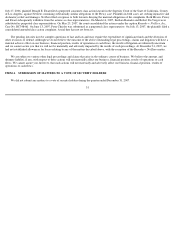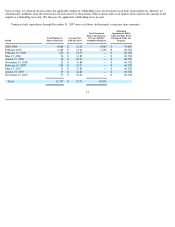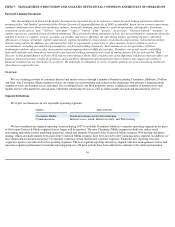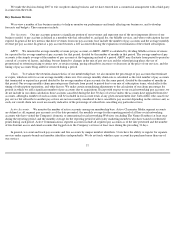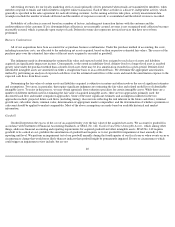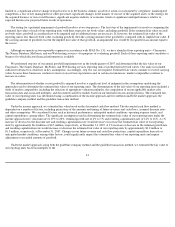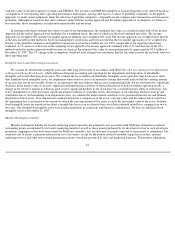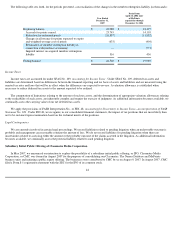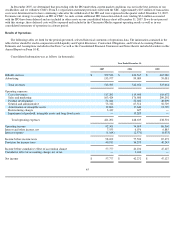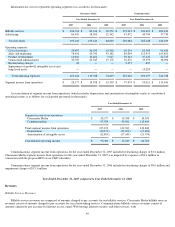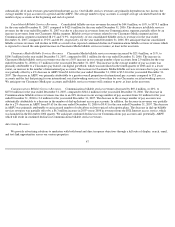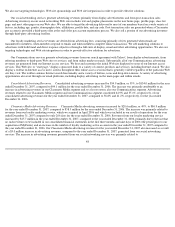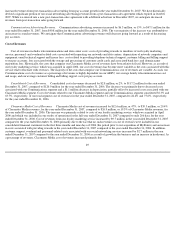Classmates.com 2007 Annual Report Download - page 42
Download and view the complete annual report
Please find page 42 of the 2007 Classmates.com annual report below. You can navigate through the pages in the report by either clicking on the pages listed below, or by using the keyword search tool below to find specific information within the annual report.
Advertising revenues for our loyalty marketing service consist primarily of fees generated when emails are transmitted to members, when
members respond to emails and when members complete online transactions. Each of these activities is a discrete, independent activity, which
generally is specified in the sales agreement for each advertising customer. As the earning activities take place, activity measurement data
(examples include the number of emails delivered and the number of responses received) is accumulated and the related revenue is recorded.
Probability of collection is assessed based on a number of factors, including past transaction history with the customer and the
creditworthiness of the customer. If it is determined that collection is not reasonably assured, revenue is not recognized until collection becomes
reasonably assured, which is generally upon receipt of cash. Deferred revenue also represents invoiced services that have not yet been
performed.
Business Combinations
All of our acquisitions have been accounted for as purchase business combinations. Under the purchase method of accounting, the costs,
including transaction costs, are allocated to the underlying net assets acquired, based on their respective estimated fair values. The excess of the
purchase price over the estimated fair values of the net assets acquired is recorded as goodwill.
The judgments made in determining the estimated fair value and expected useful lives assigned to each class of assets and liabilities
acquired can significantly impact net income. Consequently, to the extent an indefinite-lived, definite-lived or a longer-lived asset is ascribed
greater value under the purchase method than a shorter-lived asset, there may be less amortization recorded in a given period. Definite-lived
identifiable intangible assets are amortized on either a straight-line basis or an accelerated basis. We determine the appropriate amortization
method by performing an analysis of expected cash flows over the estimated useful lives of the assets and match the amortization expense to the
expected cash flows from those assets.
Determining the fair value of certain assets and liabilities acquired is subjective in nature and often involves the use of significant estimates
and assumptions. Two areas, in particular, that require significant judgment are estimating the fair value and related useful lives of identifiable
intangible assets. To assist in this process, we may obtain appraisals from valuation specialists for certain intangible assets. While there are a
number of different methods used in estimating the fair value of acquired intangible assets, there are two approaches primarily used: the
discounted cash flow and market comparison approaches. Some of the more significant estimates and assumptions inherent in the two
approaches include: projected future cash flows (including timing); discount rate reflecting the risk inherent in the future cash flows; terminal
growth rate; subscriber churn; terminal value; determination of appropriate market comparables; and the determination of whether a premium or
a discount should be applied to market comparables. Most of the above assumptions are made based on available historical and market
information.
Goodwill
Goodwill represents the excess of the cost of an acquired entity over the fair value of the acquired net assets. We account for goodwill in
accordance with Statement of Financial Accounting Standards, or SFAS, No. 142, Goodwill and Other Intangible Assets , which among other
things, addresses financial accounting and reporting requirements for acquired goodwill and other intangible assets. SFAS No. 142 requires
goodwill to be carried at cost, prohibits the amortization of goodwill and requires us to test goodwill for impairment at least annually at the
reporting unit level. We perform an impairment test of our goodwill annually during the fourth quarter of our fiscal year or when events occur or
circumstances change that would more likely than not indicate that goodwill might be permanently impaired. Events or circumstances which
could trigger an impairment review include, but are not
40



